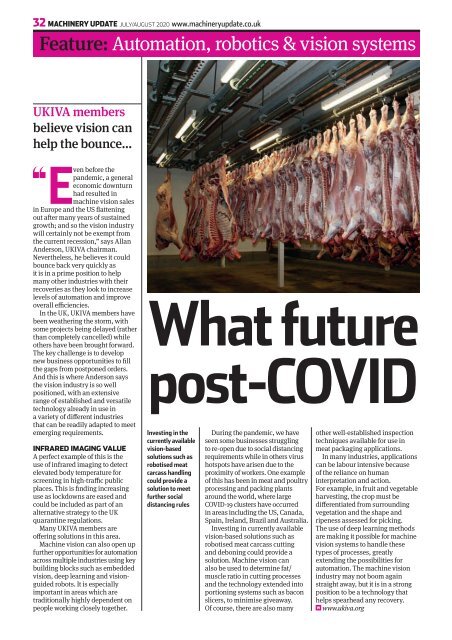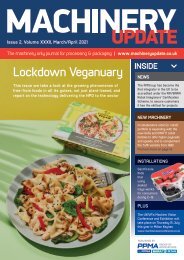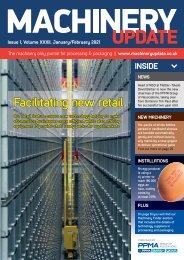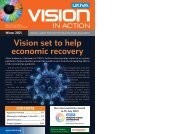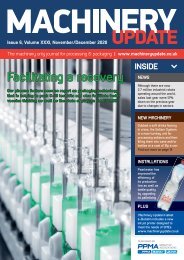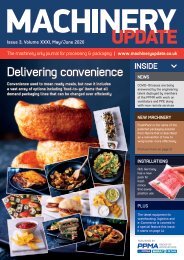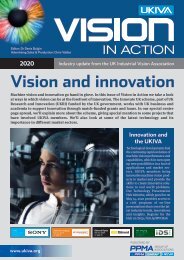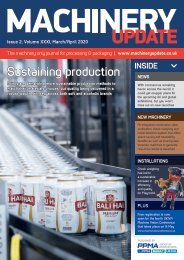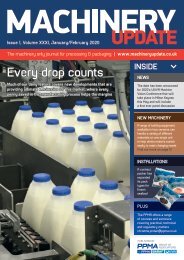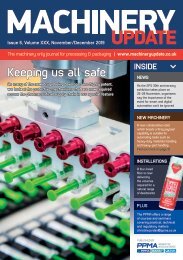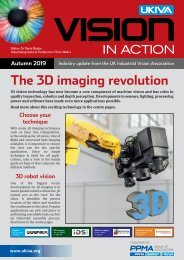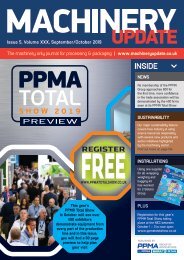Machinery Update July / August 2020
The July / August 2020 issue of Machinery Update.
The July / August 2020 issue of Machinery Update.
- No tags were found...
You also want an ePaper? Increase the reach of your titles
YUMPU automatically turns print PDFs into web optimized ePapers that Google loves.
32 MACHINERY UPDATE JULY/AUGUST <strong>2020</strong> www.machineryupdate.co.uk<br />
Feature: Automation, robotics & vision systems<br />
UKIVA members<br />
believe vision can<br />
help the bounce…<br />
Even before the<br />
pandemic, a general<br />
economic downturn<br />
had resulted in<br />
machine vision sales<br />
in Europe and the US flattening<br />
out after many years of sustained<br />
growth; and so the vision industry<br />
will certainly not be exempt from<br />
the current recession,” says Allan<br />
Anderson, UKIVA chairman.<br />
Nevertheless, he believes it could<br />
bounce back very quickly as<br />
it is in a prime position to help<br />
many other industries with their<br />
recoveries as they look to increase<br />
levels of automation and improve<br />
overall efficiencies.<br />
In the UK, UKIVA members have<br />
been weathering the storm, with<br />
some projects being delayed (rather<br />
than completely cancelled) while<br />
others have been brought forward.<br />
The key challenge is to develop<br />
new business opportunities to fill<br />
the gaps from postponed orders.<br />
And this is where Anderson says<br />
the vision industry is so well<br />
positioned, with an extensive<br />
range of established and versatile<br />
technology already in use in<br />
a variety of different industries<br />
that can be readily adapted to meet<br />
emerging requirements.<br />
INFRARED IMAGING VALUE<br />
A perfect example of this is the<br />
use of infrared imaging to detect<br />
elevated body temperature for<br />
screening in high-traffic public<br />
places. This is finding increasing<br />
use as lockdowns are eased and<br />
could be included as part of an<br />
alternative strategy to the UK<br />
quarantine regulations.<br />
Many UKIVA members are<br />
offering solutions in this area.<br />
Machine vision can also open up<br />
further opportunities for automation<br />
across multiple industries using key<br />
building blocks such as embedded<br />
vision, deep learning and visionguided<br />
robots. It is especially<br />
important in areas which are<br />
traditionally highly dependent on<br />
people working closely together.<br />
What future<br />
post-COVID<br />
Investing in the<br />
currently available<br />
vision-based<br />
solutions such as<br />
robotised meat<br />
carcass handling<br />
could provide a<br />
solution to meet<br />
further social<br />
distancing rules<br />
During the pandemic, we have<br />
seen some businesses struggling<br />
to re-open due to social distancing<br />
requirements while in others virus<br />
hotspots have arisen due to the<br />
proximity of workers. One example<br />
of this has been in meat and poultry<br />
processing and packing plants<br />
around the world, where large<br />
COVID-19 clusters have occurred<br />
in areas including the US, Canada,<br />
Spain, Ireland, Brazil and Australia.<br />
Investing in currently available<br />
vision-based solutions such as<br />
robotised meat carcass cutting<br />
and deboning could provide a<br />
solution. Machine vision can<br />
also be used to determine fat/<br />
muscle ratio in cutting processes<br />
and the technology extended into<br />
portioning systems such as bacon<br />
slicers, to minimise giveaway.<br />
Of course, there are also many<br />
other well-established inspection<br />
techniques available for use in<br />
meat packaging applications.<br />
In many industries, applications<br />
can be labour intensive because<br />
of the reliance on human<br />
interpretation and action.<br />
For example, in fruit and vegetable<br />
harvesting, the crop must be<br />
differentiated from surrounding<br />
vegetation and the shape and<br />
ripeness assessed for picking.<br />
The use of deep learning methods<br />
are making it possible for machine<br />
vision systems to handle these<br />
types of processes, greatly<br />
extending the possibilities for<br />
automation. The machine vision<br />
industry may not boom again<br />
straight away, but it is in a strong<br />
position to be a technology that<br />
helps spearhead any recovery.<br />
W www.ukiva.org


